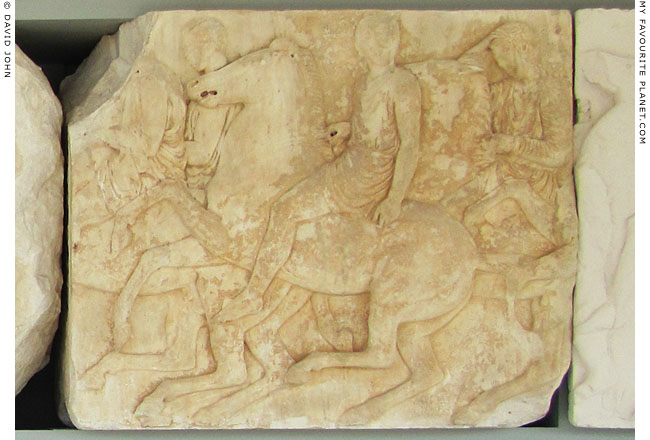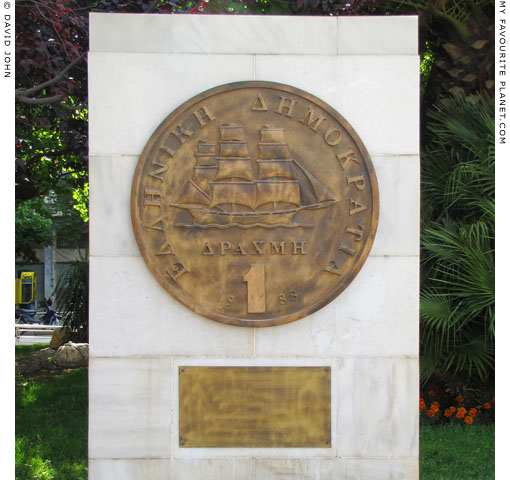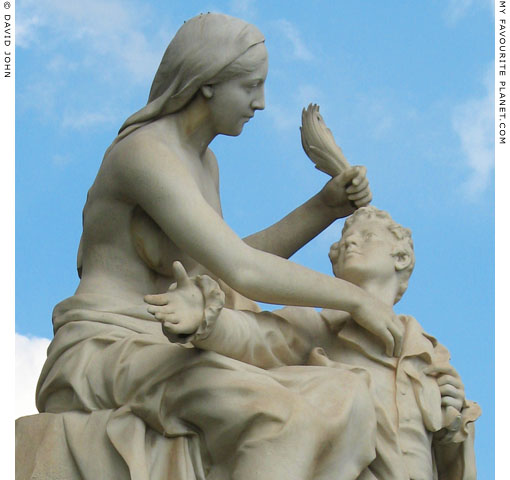|
|
 |
| My Favourite Planet > Blogs > Edwin Drood's Column > June 2011 |
 |
 |
back |
Edwin Drood's Column |
 |
21 June 2011 |
 |
| |
 |
 |
| Losing their marbles ... |
In which Edwin returns to his least favourite subject once more,
as people riot in the Streets of Athens and the wonderful polychrome
dream that is, or was, the Euro loses its few remaining feathers.
|

 |
I’m beginning to think they do it deliberately just to annoy me. I’m talking, of course, about the Greeks Can’t I simply live a quiet blogger’s life without being tempted into controversial, flagrant or provocative polemic by those denizens of the Aegean? Once again, as the rest of Europe teeters on the brink of sending them another 12 billion they have so far done nothing to deserve, you can be sure they’re going to burn the presidential palace or the parliament or smash up the Parthenon or something.

It was back in 1801 when Lord Elgin first confiscated their marbles, and so far, despite the intervention of two revolutions, several wars, a good number of Olympic games and the passage of 210 years, they have failed signally to demonstrate the kind of good behaviour – like turning in their homework on time, not cheating, learning their Euclid, getting the maths right, playing fair, getting to bed before the curfew, lights out means lights out (and no talking), being genuinely democratic and constitutional etc. – that studious Lord would deem necessary if they are ever to get them back.
 In May 2000 I made some general notes on this subject. I think they are still valid, so I shall cite them here in extenso: | |
“Although there are cogent arguments for the restoration of artefacts to their original “owners”, the key criteria for their repatriation should be as follows:
|
| 1) |
|
Major cultural or religious significance to the country or people initiating the request;
 |
| 2) |
|
Definite documentary evidence that the artefacts were acquired in an illicit manner, against the will of the initiating country or people, through theft, plunder, confiscation, coercion or force of occupation;
 |
| 3) |
|
That the artefact does not have a similarly founded significance for its current holders or other counter-claimants;
 |
| 4) |
|
That it has not been irrevocably altered after its removal in such a way as could be understood to have added significant cultural or aesthetic value (such as the cutting or setting of a gem);
 |
| 5) |
|
That it has not been incorporated into another important work, such as a frieze, screen, icon or altar at the time of that work’s original creation;
 |
| 6) |
|
That the country or people initiating the request can guarantee the future care and preservation of the artefact for an indefinite period, at least up to the current standard;
 |
| 7) |
|
That the country initiating the request, or the country where the applicant people reside, is currently enjoying a period of internal stability, political democracy, religious and intellectual freedom, which has already lasted at least 50 years (or possibly a shorter period if guaranteed by international conventions);
 |
| 8) |
|
That the first documented request for restoration occurred within 50 years of either the artefact’s initial removal or a significant change of regime (expulsion of an occupying power, fall of a dictatorship or other government without a popular mandate);
 |
| 9) |
|
That the artefact is connected to tangible cultural values. This would exclude traditions, legends or songs, and their associated musical instruments;
 |
| 10) |
|
That access to the artefact, whether it is returned from either the public or private domain to either the public or private domain, should not be diminished;
|
|
Observance of these criteria would put a stop to spurious, frivolous or purely politically motivated claims, as well as providing a serious framework for the negotiation, evaluation and processing of genuine requests.

If these criteria were applied, the Elgin Marbles could indeed be returned to Greece, but only in 2021 (see n° 5). Unfortunately, the Koh-i-noor diamond would not be returned, as 3,4 & 5 are not fulfilled.”
I might add, as an aside, that no artefact in any way representational should ever be returned to a country that has even the least history of Islamic fundamentalism, such as Britain, France, Belgium or the Netherlands: the gigantic empty alcoves left by the Bamiyan Buddhas of Afghanistan shall forever remain as a bitter warning of just how far people can be trusted with their own culture. So far no Greeks have attempted to dynamite Delphi, but in their present mood, anything is possible. Keep the marbles until they find their own.
© Edwin Drood, June 2011 |
|



 Lord Elgin Lord Elgin |
| |
 |
Big pictures and notes |
 |
|



A policeman's lot is not a happy one.

Riot police face angry protestors outside the Greek parliament in Athens.

photo: © 2011 David John |



Part of the marble North Frieze (section N XXXVI) from the Parthenon,
now in the New Acropolis Museum, Athens

photo: © 2011 David John |



Thomas Bruce, 7th Earl of Elgin, 11th Earl of Kincardine (1766-1841);
from 1799 to 1803 British ambassador to the Ottoman court
|
The "Elgin Marbles" or "Parthenon Marbles" are a collection of classical Greek sculptures and friezes from the Parthenon and other buildings on the Athens Acropolis, many by Phidias and his pupils, which Lord Elgin had removed and shipped to England between 1801 and 1812.

He claimed to have received permission for his actions from the Ottoman authorites in the form of a firman (decree), although the original document has yet to be discovered. The "acquisition" of the Marbles was controversial, and Elgin's critics in Britain called it "pillage", "loot" and "vandalism". The poet and philhellene Lord Byron objected to such removal of antiquities generally, and to this one particularly, a sentiment reflected in his epic poem "Childe Harold's Pilgrimage" (published 1812-1818):
 Dull is the eye that will not weep to see
Dull is the eye that will not weep to see
Thy walls defaced, thy mouldering shrines removed
By British hands, which it had best behoved
To guard those relics ne'er to be restored.
Curst be the hour when from their isle they roved,
And once again thy hapless bosom gored,
And snatch'd thy shrinking gods to northern climes abhorred!
 Nevertheless, he appears to have had no qualms about accepting passage from Athens to Malta on one of the Royal Navy ships which carried off part of Elgin's booty to England in April 1811. (See The Cheshire Cat Blog, July 2011.)
 Elgin offered to sell the Marbles to the British government, and following debate in Parliament and examination of the offer by a parliamentary committee in 1816, they were purchased for the British Museum (now exhibited in the museum's purpose-built Duveen Gallery). They proved a great sensation and a popular attraction, and have remained so ever since. Their popularity is further enhanced by occasional flair-ups in the press campaigns surrounding the ownership controversy.
 Successive Greek governments have requested the return of the Marbles, claiming that their removal by Elgin was illegal and immoral, especially given that Greece was occupied by the Turkish Empire at the time.
 The late 18th to mid 19th century was the heyday of private individuals, including Giovanni Battista Belzoni and Heinrich Schliemann, from rich Western countries digging up and carting off antiquities wholesale from around the Mediterranean and Middle East. Their motives, methods and scruples varied considerably.
 It could be argued that if Elgin had not removed the Marbles, it is highly likely that somebody else would have. It is reported, for example, that Napoleon had a great interest in them and made Elgin a higher offer than the British Museum. This in itself is not a justification, but perhaps an indication of the inevitability of their removal under contemporary conditions.
 Elgin himself made a strong defence for his actions, and subsequent commentators have also agreed that had the Marbles remained in situ they may have been damaged or destroyed by a number of factors, including:
 1. The Acropolis was used as a military garrison by the Ottoman Turks and the occupying Germans during World War II, and as a foothold by Britsh paratroops during the attempted left-wing revolution of 1944. It has been damaged severely during sieges, battles and bombardments several times in recent history.
 "... the Cyclopean masonry of the Mycenean strong point has been re-erected to protect an Axis gun-site and the mortar batteries of ELAS have left scars on the Acropolis that are already indistinguishable from those caused by Turkish gunners." Osbert Lancaster, Foreign Office press attaché at the British Embassy in Athens, 1944. From Classical Landscape with Figures, John Murray, London 1947.
 2. During the Ottoman occupation, marble antiquities, including those on the Acropolis, were broken up or reduced by burning to lime for building materials. It is also reported that during the siege of the Acropolis by Greek independence fighters in 1822, the Turkish defenders melted the lead clamps used to secure marble architectural parts of ancient buildings to make bullets (see Athens Acropolis gallery, page 12).
 3. Casual vandalism and theft of artefacts on and around the Acropolis continued from late antiquity into the late 20th century.
 4. In more recent years, environmental pollution caused by industry and vehicle emissions has caused irreparable damage to many of Athens' antique monuments.
 5. Let's not not forget earthquakes and other "acts of God". |
The question of the return of the "Elgin Marbles" to Greece is covered in greater depth
on Ian Swindale's website THE PARTHENON MARBLES. |
|



The Siege of Athens by Kioutachi Pasha, 1826-1827, showing cannons being fired
at the Greek defenders on the Acropolis.

The siege of Athens by Kioutachi Pasha, painting by Panayotis Zografos,
commissioned by General Makriyannis.

Lithograph from Histoire picturale de la guerre de l’indépendence Hellénique par le général
Makryiannis notice historique ... by I. Gennadius and Fr. Boissonnas. Geneva, Paris, 1926. |



Monument to the Unknown Drachma. RIP.

Opposite the National Bank of Greece, Athinas Street, Athens.

photo: © 2011 David John |



Greece personified lifts Lord Byron's wallet while diverting his attention with a chicory leaf.

Detail of a training statue for pickpockets by A. Falcuire. National Gardens, Athens.

photo: © 2007 David John |
Edwin Drood's Column, the blog by The Mysterious Edwin Drood,

at My Favourite Planet Blogs.
We welcome all considerate responses to this article
and all other blogs on My Favourite Planet.
Please get in contact. |
 |
Visit the My Favourite Planet Group on Facebook.

Join the group, write a message or comment,
post photos and videos, start a discussion... |
|
Views of blog authors do not necessarily reflect those of the publishers
or anyone else at, on or in the vicinity of My Favourite Planet. |
 |
 |
|
|
| |
| |
|
| |
 |
| |
 |
| |
 |
| |

George Alvanos

rooms
in Kavala's historic Panagia District

Anthemiou 35,
Kavala, Greece

kavalarooms.gr
 |
| |

Olive Garden Restaurant

Kastellorizo, Greece

+30 22460 49 109

kastellorizo.de
 |
| |

Papoutsis
Travel Agency

Kastellorizo, Greece

+30 22460 49 286

greeklodgings.gr
 |
| |
|